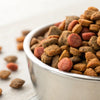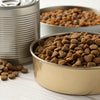How Much Dry Dog Food for a 55 lb Dog: A Comprehensive Guide
- Houndsy
Table of Contents
- Introduction
- Understanding Dog Nutrition
- Dog Feeding Guidelines
- The Role of Treats
- Monitoring Your Dog's Weight
- Conclusion
- FAQs
Introduction
Did you know that approximately 59% of dogs in the United States are either overweight or obese? This striking statistic highlights the crucial importance of understanding how much food to feed our furry friends. As dog owners, we want to ensure that our pets remain healthy, energetic, and happy. However, determining the right portion sizes can often feel like a daunting task, especially for a 55 lb dog.
In this blog post, we will explore the intricacies of dog nutrition and provide you with specific insights on how much dry dog food is appropriate for a dog of this weight. By the end of this guide, you will have a clearer understanding of the factors that influence your dog’s dietary needs and practical strategies to ensure they receive the right amount of food. We will also introduce innovative products, like the Houndsy Kibble Dispenser, that simplify the feeding process while enhancing the aesthetic appeal of your home.
Let’s embark on this journey to better understand our four-legged companions' nutritional needs and create a fulfilling feeding routine that serves both their health and our lifestyle.
Understanding Dog Nutrition
Proper nutrition is vital for your dog’s overall health and well-being. Just like humans, dogs require a balanced diet consisting of proteins, carbohydrates, fats, vitamins, and minerals. Insufficient or excessive feeding can lead to various health issues, including obesity, malnutrition, and digestive problems.
Daily Caloric Needs
The daily caloric requirement for dogs is generally calculated using a formula that considers their weight, activity level, and life stage. The average maintenance energy requirement (MER) is calculated as follows:
MER (Calories per day) = 30 x (body weight in kg) + 70
For a 55 lb dog, this translates to approximately 25 kg (since 1 lb = 0.45 kg):
MER = 30 x 25 + 70 = 820 calories per day (approx.)
This number can vary based on factors such as activity level, age, and overall health.
Factors Influencing Food Intake
- Activity Level: Active dogs require more calories than sedentary ones. Regular walks, playtime, and agility training all contribute to higher caloric needs.
- Age: Puppies and young dogs have higher energy demands for growth and development, while senior dogs often require fewer calories due to decreased activity levels.
- Body Condition Score (BCS): This score assesses whether a dog is underweight, ideal, or overweight. Adjusting food intake based on BCS is crucial for maintaining a healthy weight.
- Health Status: Certain health conditions may require dietary adjustments. For example, dogs with diabetes may need a regulated diet, while those with kidney disease may require special food.
Dog Feeding Guidelines
When it comes to feeding a 55 lb dog, general guidelines can provide a useful starting point. Most feeding guides will recommend a daily food intake based on weight:
For a 55 lb dog, the recommended daily feeding amount typically ranges between 2.5 to 3.5 cups of dry dog food. This can vary based on the specific caloric density of the food you choose.
Reading Dog Food Labels
It’s essential to refer to the feeding guidelines on your specific dog food packaging. Different brands and formulations will have varying caloric contents, which can significantly influence how much you should feed your dog. A feeding chart typically indicates the suitable daily amount based on weight, which helps you gauge how much to scoop out.
Feeding Frequency
For most adult dogs, feeding them twice a day is ideal. This helps regulate metabolism and prevent the risk of bloat, which can occur in some breeds when they eat too quickly. Puppies or dogs with specific dietary needs may require more frequent meals.
The Role of Treats
While it’s tempting to spoil our dogs with treats, it’s essential to factor these into their daily caloric intake. Treats should not make up more than 10% of your dog’s daily calories. For a 55 lb dog, this means limiting treats to around 80 calories per day.
Choosing Healthy Treats
Opt for healthy, low-calorie treats that provide nutritional value. Consider options like:
- Carrot sticks
- Green beans
- Store-bought treats with low-calorie counts
Utilizing the Houndsy Kibble Dispenser
At Houndsy, we believe that feeding your dog should be as convenient and enjoyable as possible. Our Houndsy Kibble Dispenser is designed not only for functionality but also for style, fitting seamlessly into your home decor.
Key features include:
- Perfect Portion Control: The dispenser allows you to deliver the right amount of food every time, ensuring your dog receives the correct daily caloric intake.
- Ergonomic Design: With a convenient crank at standing height, there’s no need to bend down, which also helps eliminate mess during feeding.
- Large Capacity: With a capacity of 25-30 lbs, you can store enough kibble for several weeks without needing constant refills.
- BPA-Free Liner: Our dispenser features a BPA-free liner that maintains kibble freshness.
For more information and to enhance your dog-feeding experience, explore the Houndsy Kibble Dispenser.
Monitoring Your Dog's Weight
Regularly monitoring your dog’s weight is crucial in ensuring they are receiving the appropriate amount of food. We recommend weighing your dog every few months or during vet visits.
Adjusting Food Amounts
If your dog is gaining weight, consider gradually reducing their food intake by about 10% and monitor their weight. Conversely, if they are losing weight or seem lethargic, you may need to increase their caloric intake.
Consulting with Your Veterinarian
The best way to ensure your dog is receiving the correct amount of food is to consult your veterinarian. They can provide personalized advice based on your dog’s specific needs, activity level, and health status.
Conclusion
Feeding your 55 lb dog the right amount of food is critical to their health, happiness, and longevity. By understanding their daily caloric needs and adjusting their diet based on activity level, age, and body condition, you can ensure they receive the nutrition they require. Utilizing innovative products like the Houndsy Kibble Dispenser can simplify this process, making feeding time an enjoyable ritual rather than a chore.
As you reflect on your dog's feeding habits, consider these questions:
- How does your dog's activity level impact their food needs?
- Have you explored innovative feeding solutions like the Houndsy Kibble Dispenser?
Explore the Houndsy Kibble Dispenser today and elevate your dog's feeding experience!
FAQs
How do I know if I’m overfeeding my dog? Overfeeding can lead to weight gain and obesity. Look for signs such as difficulty in feeling your dog's ribs or seeing a sagging belly.
Can I feed my dog homemade food? Yes, but it’s essential to consult with a veterinarian or a pet nutritionist to ensure that the homemade diet meets all of your dog's nutritional needs.
What should I do if my dog refuses to eat? If your dog refuses to eat, first ensure that the food is fresh and safe. If the issue persists, consult your veterinarian, as it may indicate underlying health concerns.
How often should I change my dog’s food? If switching dog food brands or formulas, do so gradually over a week to avoid digestive upset. Consult your vet if your dog has special dietary needs.
Can I free-feed my dog? Free-feeding is generally not recommended as it can lead to overeating and obesity. Scheduled feeding at specific times is usually the best practice to maintain a healthy weight.
By taking the time to understand your dog's needs and utilizing the right tools, we can ensure a happier, healthier life for our furry friends.













